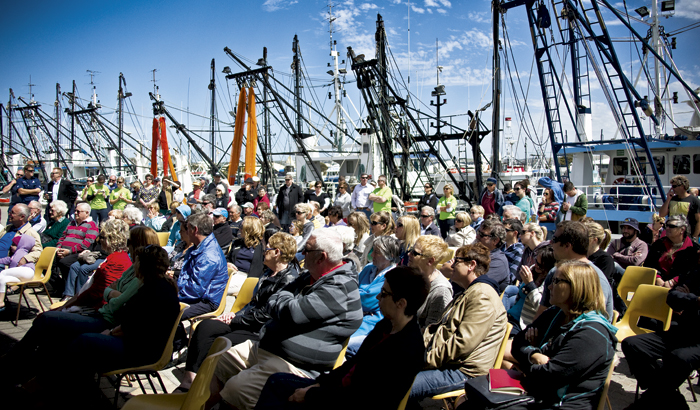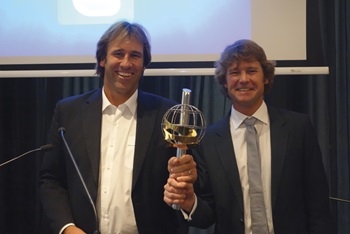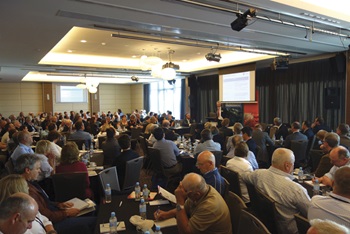The seafood industry’s national conference focused on the importance of connecting with consumers and markets in Australia and abroad to tell the industry story
 Photo: Steven Davies
Photo: Steven Davies By Alexandra Roginski
The theme of the 2013 Seafood Directions Conference, hosted on 27 to 30 October this year on South Australia’s Eyre Peninsula, was ‘Adapt, Interact & See Food’.
These themes were reflected in many of the events and presentations at the four-day event, at which market opportunities arising from evolving international tastes for seafood, the need for the industry to develop a unified front and the importance of community engagement were discussed.
The conference itself began by engaging the local community through the Family and Fishers Trade Show held at the Port Lincoln Marina. This featured cooking demonstrations by Hong Kong’s three-time Iron Chef winner Wong Wing Chee and a dragon boat race that pitted conference delegates from three different states against each other.
Holding Seafood Directions in one of Australia’s premier seafood ports proved an outstanding success, says the FRDC’s communications manager Peter Horvat, who was a member of the conference organising committee.
“The town was humming with seafood industry representatives from across Australia and even a couple from New Zealand. It was pleasing to see the number of local industry people who attended, even if it was just for a coffee and a chat with friends they knew. I think holding conferences and events like this in bigger regional areas has significant value, not only to the participants but the whole community,” Peter Horvat says.
Industry awards
 Jonas Woolford (left) hands baton to Brad Adams, chair of the Western Australian Fishing Industry Council
Jonas Woolford (left) hands baton to Brad Adams, chair of the Western Australian Fishing Industry Council More than 240 seafood industry representatives attended workshops and presentations at the Port Lincoln Hotel as part of the conference.
The Port Lincoln Hotel ballroom was at capacity for the three-day conference, and the conference’s 7th National Seafood Industry Awards dinner on Sunday night attracted more than 300 people to the Nautilus Theatre, where 32 of the industry’s most outstanding leaders were inducted into the Seafood Hall of Fame.
FRDC executive director Patrick Hone reflected that the Hall of Fame announcements represented a new kind of celebration of the industry’s most dynamic players.
“One of the really poignant things for me was we recognised those who were present and not present, and those who have passed away. Every year in this industry we lose many great people. It is a fantastic thing that we will remember the people who have done great things in this industry,” Patrick Hone said.
The 2013 National Seafood Industry Awards were also presented during the dinner, with 11 winners announced as the industry leaders across a range of categories including production, research, promotion, education and training (see "National awards honour industry leaders").
Clean green message
This year’s conference saw widespread recognition and adoption of premium, ‘clean and green’ branding within the industry following presentations at the 2011 conference that called for Australia’s strong fisheries management to be translated into a marketing advantage.
Leading the charge at the conference was Federal Senator Richard Colbeck, Parliamentary Secretary to the Minister for Agriculture.
“We’ve got a good story to tell about our fisheries here in Australia and we need to start telling it to people. We’ve done a lot of hard work and there’s been a lot of pain as part of that process. That needs to be recognised,” Senator Colbeck said.
One of the major avenues for boosting revenue in the Australian seafood industry hinges on forging stronger connections with China. This was the subject of a presentation by Sam Guthrie, associate partner with strategic communications company Newgate, who works with Australian primary industries to help them gain access to this powerful market.
Trade with China
He said that until now many Australian seafood exporters have taken a ‘lone wolf’ approach to their relationship with China, relying on a relationship with one key importer.
Industry unity was necessary if Australia was to compete with other countries, such as Chile and New Zealand, for a share of the market, he said, with the latter country’s trade delegations particularly visible in China.
He said that Australia has a story to tell about the ‘romance’ of its landscape.
“If you’re living in the midst of a second-tier or third-tier Chinese city, the idea of rolling hills or blue sea around Australia is something that propels you into wanting to buy something,” Sam Guthrie said.
A presentation from the Australian Wild Abalone (AWA) group and the Australian Seafood Cooperative Research Centre (Seafood CRC) added to this with an overview of their efforts to establish markets in China.
The AWA group is a collective of 10 abalone companies that this year launched a new marketing and branding campaign in China focused on the story behind their wild-caught product.
Jayne Gallagher, program manager (product and market development) at the Seafood CRC, and Jonas Woolford, of abalone company Eyrewoolf Enterprises, described their efforts to engage with the Chinese supply chain over the past two years.
They said the depictions of the pristine waters from which Australian abalone is harvested promotes the exotic nature of the product and of abalone diving itself.
Community power
 Photos: FRDC
Photos: FRDC Community engagement was repeatedly identified as crucial for the survival of the Australian seafood industry.
Environmental consultant Nicky Mazur, an Adjunct Research Fellow at Charles Sturt University, reported on extensive data on the social acceptability of the commercial fishing sector collected through surveys.
“Overall, we found that there are strong levels of acceptance of the sector, but that acceptance was conditional upon people believing that the sector could be effectively regulated and be able to demonstrate its environmental stewardship,” Nicky Mazur said.
“Respondents were also supportive of Australian seafood, versus imports that might come from countries with lower standards of environmental protection.”
She said that those people who rated the industry’s acceptability lower had stronger environmental concerns and were more concerned about government ability to regulate over fishing. The industry needed to focus on long-term trust-building, she suggested.
“Controversy often happens because of inadequate engagement. Perhaps less time should be focused on the sector’s problems, and more time devoted to identifying a more aspirational and positive vision for the sector; one that may have better synergy with dominant social norms and that make it easier to gain widespread stakeholder involvement and public support. For instance, continual improvement and environmental stewardship and how the sector provides healthy seafood.”
The importance of building trust through transparency was highlighted by Fiona Ewing, community engagement officer for Atlantic Salmon (Salmo salar) producer Tassal, who discussed the company’s reporting on environmental management. “I’m just putting together our third sustainability report, and we have never had any bad feedback,” she said.
Summarising the conference, Patrick Hone spoke about the importance of the many different sectors of the industry coming together.
He described the collective role of recreational fishers, represented at the conference by the managing director of the Australian Recreational Fishing Foundation, Allan Hansard, as “an incredibly strong alliance … of a very diverse group of people”.
He also forecast that the FRDC would be boosting its work with Indigenous communities.
“We want to mainstream the word ‘Indigenous’ into fishing. You will see a lot more proactive work from the FRDC to try and profile and include Indigenous people in the work we do.”
The 2015 Seafood Directions Conference and National Seafood Industry Awards presentations will be held in Perth.
FRDC director Peter O’Brien provided the final summing of the conference, identifying four issues from the content of the conference that would require a unified response:
- Social licence to operate;
- Market access;
- Sustainability; and
- Productivity.
These were not issues that any one individual or group could resolve, he said.Peter O’Brien said FRDC was now beginning the conversation to shape its next five year research, development and extension plan.
“We want to deliver the science impact for vibrant sustainable fisheries. We think that our R&D plan can and should be set within a narrative of what industry, government and the community want.”
Peter O’Brien called for input and ideas from all participants on how the FRDC could help assist taking the Australian seafood industry forward.
Family fishers tell their stories
Alexandra Roginski
Twelve months ago, the career of Spanish Mackerel (Scomberomorus commerson) fisher Bruce Davey took a surprising turn. Through an unexpected meeting of minds and passions, the proud captain of the FV Wildcard, who earns his living on the Gulf of Carpentaria, found himself producing a documentary film.
Drawing the Line tells the story of family fishing businesses from around Australia as they seek to adapt to the changes to their fishing territory expected to result from the introduction of the proposed Australian marine parks. The film premiered as part of the Seafood Directions Conference in Port Lincoln, South Australia, and was introduced by Senator Richard Colbeck.
The idea for the film sparked when Bruce Davey employed a new deckhand – Alaneo Gloor, the son of a friend and a recent graduate from a film course at Melbourne’s Swinburne University. The young filmmaker started scribbling a script for a film that tells the story of the Davey family and the FV Wildcard.
Soon they were joined by film and TV insider Matt Blyth, who recently worked on The Great Gatsby. What was originally intended as a series of YouTube videos ended up embracing fishing stories from around the country.
“The three of us went around Australia, every state and territory: filming, putting Drawing the Line together, doing multiple interviews with multiple people, and here I am 12 months later, pretty damn proud to say that we’ve produced an amazing, heartfelt documentary,” Bruce Davey says.
The film also draws on the expertise of fisheries scientists Colin Buxton and Caleb Gardner of the University of Tasmania and Bob Kearney of the University of Canberra.





